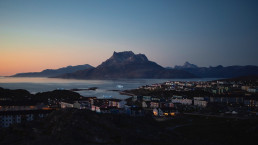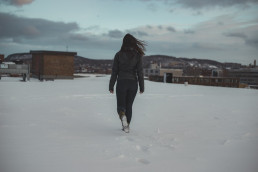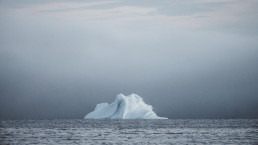Part of the Arctic Opportunity Explorer Challenge
Gender equality and health in the Arctic region are like icebergs. Many of the issues are invisible, they have a complex history, and they have potential to wreak havoc. They are two of the Sustainable Development Goals that are largely overlooked in a region that is commonly and simplistically associated with ice, climate change, and polar bears.
As part of the Nordic Council of Minister’s Nordic Arctic Co-operation Programme, the Arctic Opportunity Explorers challenge is encouraging students to collaborate digitally across disciplines and countries to explore these issues in more detail and innovate to help society navigate them safely and effectively.
Here we explore some of the issues under the surface of these sustainable development icebergs in the Arctic.

Gender has an intriguing history in indigenous arctic communities
Much like icebergs, there is more to gender issues in the Arctic than meets the eye. For many, an association between the Arctic landscape and an inherently masculine way of life may exist, brought about in part by the fact that many early external visitors and writers were male. In fact, in many traditional Arctic communities, there is a marked sense of ‘genderlessness’ among residents, with each person seen as a human being above all else. This lack of a focus on characteristics determined by sex is represented in many northern indigenous languages around the world, which feature non-gendered terminology. For this reason, it is important to consider gender equality issues in a uniquely Arctic context, taking into account the role that external forces have had in shaping gender inequalities in the region.
From stable beginnings, colonialism and globalisation have carved out the iceberg of gender inequality. In many circumstances, the gender issues we see today were previously absent in northern societies. In pre-colonial times, although men and women had different roles, women were usually family and community leaders who played an important role in long-term decision making. Colonial powers began to undermine the traditional leadership roles that many women occupied, and began to import patriarchal norms and beliefs into northern communities, contributing to some of the gender inequalities that can be seen today in Arctic societies.
Of course, gender inequality is not the same throughout the Arctic, and some of the top countries in the world for gender parity are in the Arctic. The World Economic Forum’s Global Gender Gap Index Report of 2020 found that Iceland, Finland, Norway, and Sweden all ranked amongst the top 5 in the world. At the same time, if the Arctic and far northern regions in each of these states were considered separately, studies have shown that the level of human development and gender equality would be significantly lower than what is depicted in countrywide averages. In this way, some of the most vulnerable groups, including indigenous and rural women, have not been afforded the same progress and opportunities.
Potentially as a result of this unequal opportunity distribution, the Arctic is now seeing the recently observed phenomenon of female flight. The main industries in the Arctic that are replacing traditional ways of life, such as industrialised fishing and mining, tend to attract more men, and so women leave in pursuit of education and a better way of life. For example, the development of the male-dominated mining industry in the northern Norwegian region of Finnmark has resulted in a low unemployment rate of 3%, but has also contributed to an increased number of women leaving the community in search of opportunities. Increasingly in cases like this, disproportionate numbers of women are leaving rural areas in search of higher education and urban jobs available elsewhere.
In the Faroe Islands, a similar outflux of females has occurred, leading to a degree of sex imbalance and a shortage of women of marriageable age. It is important to consider what this wide scale emigration may mean for communities as a whole, as a lack of diverse voices in decision-making positions may contribute to furthering gender inequalities in the future.

Gender also influences topics of health and well-being
One of the darkest and difficult health challenges to confront in the Arctic is suicide. Suicide is not a myth in the Arctic, and it is disproportionately an issue for young men in northerly regions. Greenland is the country with the highest rate of suicides in the world, but when broken down into Northerly communities, many of the other Arctic countries also have troubling rates. It’s not only a male issue though; among Saami youth, more girls than boys attempt suicide, and in Alaska, females attempt suicide four times more often than men and report higher rates of depression.

Exposure to heavy metals worrisome for rural communities
Another health issue with a gender component is the increasing prevalence of heavy metals and Persistent Organic Pollutants (POPs) in the diets of rural and traditional communities — particularly for pregnant women. These pollutants are served onto the plates of Arctic communities after long-distance circulation in atmospheric and ocean currents, where they then accumulate up through the food chain to create dangerous levels in mammals and fish, on which some communities rely for their food source. Exposure to high levels of contaminants can lead to higher risks of cancer, allergies, decreased cognition, and can disrupt the reproductive and/or immune system of adults and unborn babies. Although the Stockholm Convention set out a range of control measures to reduce and, where feasible, eliminate persistent organic pollutants in 2004, it remains an unpleasant challenge for many rural Arctic communities.
Flares of violence
Unfortunately, rates of violence are among the highest in Arctic countries. In Greenland, 47% of women and 48% of men have been subject to violence at least once in their lifetime, and it is estimated that Greenlandic children are subject to violence and sexual assaults nine times more frequently than in Denmark and Norway. Domestic violence against women is also prevalent, as is rape. There is no singular reason for the high levels of violence in Arctic communities but some believe that difficult economic conditions, isolated locations, loss of traditional ways of life, as well as substance abuse could all be factors that play a role. Many are concerned that the impact of COVID-19 could worsen the existing risks for domestic abuse.
In a region experiencing all sorts of changes, from environmental changes in temperatures and sea-ice levels, to socio-economic fluxes of emigration and foreign investment, the Arctic still has two huge social icebergs to navigate: gender inequality and good health and well-being. They are significant barriers to sustainable development for all of the varied communities that call the Arctic home, but we only understand the tip of the problem, and certainly have a way to go to safely navigate them. We are intrigued to see what kind of problems and solutions the Arctic Opportunity Explorers can identify within this arena, and look forward to helping them along the journey.